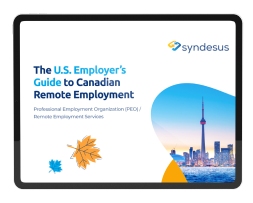As the war for tech talent continues in 2023 and beyond, companies are constantly devising creative strategies to retain their top talent. Post-COVID, the appetite for remote work and global relocation has soared so immigration as a benefit is becoming a key retention strategy.
Notably, many tech firms, particularly those with significant operations in India, are viewing relocation packages to North America as a potential benefit for those employees that they want to cultivate and promote.
This article explores the rise of this trend, delves into the various relocation options available in North America, and how Canada’s “tech visa” might be the best route of them all.
Let’s jump in.
Immigration as a benefit is a great retention strategy, here’s why
Relocation packages have become an increasingly popular retention strategy for tech workers, with 60% of employers in 2022 offering relocation assistance as a benefit, up from 45% in 2018. This is likely due to the globalization of the tech industry, the high demand for skilled tech workers, and the increasing willingness of tech workers to relocate for new opportunities.
It makes sense that relocation is becoming an attractive benefit, it can help tech workers acquire new career skills and expand their professional networks. Also, by relocating to a new city or country, they can gain exposure to new technologies and work with new people allowing them to stay ahead of the curve in their careers. Tech workers are also able to experience a different culture or way of life, or simply see more of the world, this can be a rewarding experience both personally and professionally.
For employers, offering relocation assistance can help to attract and retain top talent, improve employee morale and productivity, and create a more diverse and inclusive workplace. In a competitive market, offering relocation assistance can be a way to differentiate your company from other employers. By relocating tech workers from different backgrounds and cultures, companies can create a more dynamic and innovative work environment.
Companies have multiple ways to move their top talent from India to North America
Moving top tech talent from India to North America can be a beneficial strategic move for multinational companies. India has a large pool of highly skilled and experienced tech workers to draw from, and moving them to North America means the company can have their employees in a more favorable time zone and be able to attend meetings in person when needed.
There are a number of immigration pathways companies can use to move top talent from India to North America, these are the most common methods:
L-1A / L-1B Intracompany transfer (USA)
The L-1A visa is for executives and managers of multinational companies who are being transferred to a temporary assignment in the United States. To qualify, the employee must have worked in a managerial or executive capacity for their employer outside of the United States for at least one year in the three years preceding the transfer. An L-1B visa is similar but differs in that the employee must have specialized knowledge that is essential to the company’s operations but may not be in a managerial position.
The L-1A/ L-1B visas are a good option for companies that want to move top tech talent to the United States for a set period of time, for example, to launch a new product or service, or to manage a specific project. Holders can stay in the US for one year and can apply for extensions.
H-1B Tech Visa (USA)
The H-1B visa is a good option for companies that want to bring in skilled workers — such as tech workers — from outside of the United States. Generally, H-1B visa holders can stay in the US for up to six years. While the H-1B visa program offers an invaluable pathway to working in high-demand sectors in the US, the increasingly challenging immigration process, and a capped number of H-1Bs available, mean there is a level of uncertainty that is causing workers to consider their options.
Intracompany Transfer Visa (Canada)
The Canada Intracompany Transfer (ICT) transfer program allows key employees of a company that has a parent, branch, or affiliate company or is looking to open up a new office in Canada, to be able to move to Canada and get work authorization. To qualify for an ICT visa, the employee must have worked for the company for at least one year in the three years preceding the transfer.
Typically, ICT applicants qualify for a 2-week processing time under the Global Skills Strategy. Once accepted, the duration of the Intra-Company Transfer work permit is seven years for executives and senior managers and five years for specialized knowledge workers.
Global Talent Stream (Canada)
Another option is the Canada Global Talent Stream (GTS), a fast-track immigration program for highly skilled workers in select in-demand occupations. To qualify for the GTS, the employee must have a job offer from a designated employer and must meet certain criteria, but can be approved for a work permit in as little as two weeks. Once an employee has a GTS work permit, they can begin working in Canada and subsequently apply for permanent residency.
For companies that want to hire, promote, and retain remote talent in India, Canada’s Global Talent Stream is the best option
Canada offers a number of advantages for companies that are looking to move top tech talent from India to North America, including a streamlined and quick immigration process.
Here’s why we think Canada’s GTS is the best option:
1. Ease and speed of getting a work permit
The GTS is a fast-track immigration program for highly skilled workers in select in-demand occupations, which includes many tech roles. This means that tech workers from India can be approved for a work permit in as little as two weeks, much faster than a US work permit.
Additionally, Canada has a skills shortage in many tech areas, so tech workers from India are in high demand. This means that they are more likely to be approved for immigration and have a smooth relocation process.
2. Fast permanent residency process
If the employee has worked in Canada for at least 12 months and meets other eligibility criteria like language skills, they can apply for permanent residency through Canada Experience Class. It’s especially appealing because it is designed to provide a quicker transition from temporary worker status to permanent residency. This means that if they are happy in Canada, they have an option of building a life there much quicker than other countries, such as the US.
3. Fast citizenship process
After living in Canada for three years as a permanent resident, a tech worker from India can apply for citizenship. The citizenship process is also relatively fast and straightforward provided they meet other eligibility criteria such as language proficiency and time spent in Canada. Once a tech worker is a Canadian citizen, they have all the same rights and privileges as a native-born Canadian with all the benefits that entails.
4. No need to have a Canadian entity for GTS
The US tech company must have a Canadian entity to sponsor a tech worker from India for an intra-company transfer (ICT) to Canada. This can be a costly and time-consuming process. However, the GTS does not require the US tech company to have a Canadian entity.
Instead, the company can use a Canadian Employer of Record (EOR) to sponsor the tech worker — the EOR will take over many of the technical aspects of employment but the employee’s responsibilities will remain with the US employer.
Syndesus can help US companies without a Canadian office remotely hire tech talent from India
Whether you have an office in Canada or not, Syndesus can help you hire or move your skilled tech workers to Canada. You can bypass the uncertainty, lottery, and backlogs and instead, hire and retain all the skilled tech employees you need, remotely in Canada.
As an EOR, Syndesus can legally hire your current or prospective employee in Canada while taking care of the immigration, billing, HR, legal and other paperwork.
Reach out to us to learn more about how we can help you hire and retain talent remotely in Canada!

About Marc Pavlopoulos
Marc Pavlopoulos is the CEO and Founder of Syndesus, a Professional Employer Organization that provides PEO services for US companies seeking to employ workers remotely in Canada, builds engineering teams in Canada for VC-backed startups in the US, and set-up remote offices in Canada for US companies. Additionally, Syndesus can assist foreign-born tech workers (and their US employers) with options for working remotely in Canada if they cannot stay in the US due to immigration/work visa issues.
As an American who has moved to Canada twice (for grad school and for work), Marc understands the challenges involved in starting a new life in a new country. Marc is a son of an immigrant and has great respect for people who leave their home country and seek a better life in the US or Canada.
Marc’s goal is to do everything he can to help those individuals achieve their dreams. Marc also has a second venture (Path to Canada) which helps foreign-born technical workers who cannot stay in the US (for immigration reasons) get a job and work authorization to work in Canada.






